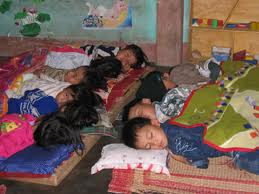 New findings from brain researchers at University College London in the U.K. suggest that sleeping rats have the capacity to imagine a place they have never been in waking. This intriguing study does more than support the idea that many animals do indeed dream, in modes appropriate to the neural capacities and environmental experiences of their species. Beyond that, the study shows that rat dreams may have one of the key features of human dreaming, namely the ability to simulate future scenarios and prepare for anticipated efforts to achieve our goals.
New findings from brain researchers at University College London in the U.K. suggest that sleeping rats have the capacity to imagine a place they have never been in waking. This intriguing study does more than support the idea that many animals do indeed dream, in modes appropriate to the neural capacities and environmental experiences of their species. Beyond that, the study shows that rat dreams may have one of the key features of human dreaming, namely the ability to simulate future scenarios and prepare for anticipated efforts to achieve our goals.
Titled “Hippocampal place cells construct reward related sequences through unexplored space” and published in eLife on June 26, the researchers built on previous work showing the importance of the hippocampus in remembering places and forming mental maps of where we have been. The hippocampus is also important for imagination, forethought, and planning future goals. Crucially for this study, the hippocampus is active in waking and sleeping, and researchers have long known that the same hippocampal “place neurons” triggered into firing by a waking-life experience of a particular place will also fire during sleep. The challenge of this study was to find out if hippocampal neurons associated with a place will fire in sleep before any waking experience of the creature actually being in that place. In other words, will the sleeping brain anticipate a desired action? Will it dream of the future?
The experiment involved training rats (with electrodes implanted in their brains) to run through a maze where they could see, but not reach, another chamber where food was visibly located. The rats could also see but not reach an additional chamber with no food. During rest periods, the researchers recorded the rats’ hippocampal activity. Then the researchers let the rats run through the maze with no blockages, so they could reach the new chambers. It turned out the rats’ hippocampal activity when they first entered the new chamber with food was a close match with their hippocampal activity in sleep—the same place neurons that first fired in sleep later fired in waking life, too. The rats seemed to dream of going into that chamber before they actually did so.
The same effect was not found in relation to the chamber with no food. The preceding rest period did not include any hippocampal activity related to the rats’ later experiences in that place. This finding led the researchers to stress the significance of desire and intrinsic motivation in triggering this “preplay” effect.
The ultimate conclusion of the study was that “goal-biased preplay may support preparation for future experiences in novel environments.” These results give us a better understanding of how preplay, or imagination in a more general sense, can “simulate future experiences in environments yet to be actively explored,” in humans and in other species.
The limits of this research are considerable. Only four rats were used as participants; the periods of “rest” were not clearly sleep stages of any specific kind; and the published results depended on an extremely technical analysis that could allow for many hidden errors. These limits should add a note of caution when assessing the possible implications of the research.
That being said, the findings of this study have a clear affinity with theories of dream function that emphasize the values of the anticipatory simulations frequently occurring in dreaming experience. C.G. Jung spoke of “the prospective function” of dreams, Montague Ullman said dreaming worked to maintain an optimal state of “vigilance,” Frederick Snyder viewed sleep and dreaming as a “sentinel” system to prepare for environmental danger, Rosalind Cartwright argued that dreams serve as “rehearsals” for future actions, and Jeremy Taylor has focused on recurrent nightmares as warnings of psycho-spiritual danger in the dreamer’s waking life. Antti Revonsuo and Katja Valli have been developing the “Threat Simulation Theory” as a way of connecting typical patterns in dream content with brain functioning and the evolutionary challenges of our species. In my 2016 book Big Dreams: The Science of Dreaming and the Origins of Religion, I will talk at length about the capacity for creative forethought and visionary insight in dreaming.
All of which is to say, dream researchers from other areas have been working with similar ideas for years, and these new findings from the University College London team are a welcome addition to the accumulating evidence in favor of dreams having some kind of preparatory function that helps to orient the individual toward successful adaptation in the waking world.


